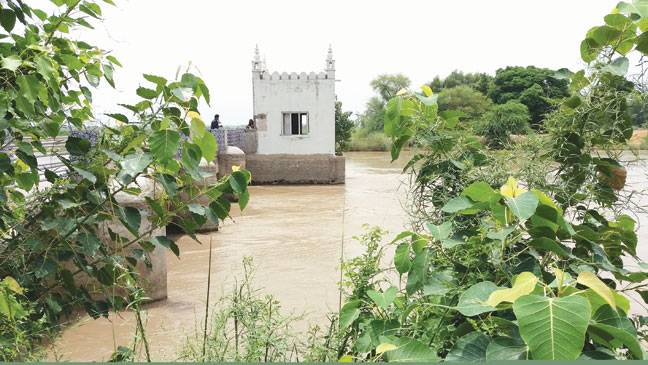SHIKARPUR - Shikarpur district, known as Paris of Sindh, is also renowned for being land of the Sufis, spiritual leaders as well as the land of historical sites.
A century-old ‘Water Masjid’ is one such historical site, which stands on seven pillars at the center of Kheerthar Canal [a famous canal of Sindh].
It is situated in village Mandho g Waand near Garhi Yasin tehsil of district Shikarpur, and was built on the instructions of prominent spiritual leader Syed Taj Mehmood Shah Amroti, who had translated the holy Quran into Sindhi language for the first time and described every word of holy Quran in detail.
Syed Taj Mehmood Shah Amroti, son of Abdul Qadir Shah Alias Bhoral Shah, was born in district Khairpur’s small village “Deewani” in 1858, and after getting religious education he migrated to Shikarpur district’s small village Amrote Sharif on the directions of his spiritual leader Hafiz Muhammad Siddique Bharchondi.
After moving to Amrote Sharif, Syed Taj Mehmood Shah built a seminary, a centre for spiritual education, and started preaching Islamic teachings and imparting spiritual education. As a result he gained eminence, and during this period he built a small mosque beside Amrote Sharif, at stone’s throw from the seminary for meditation purposes.
According to Rushdullah Shah Amroti, his grandson, Molana Ubedullah Sindhi had also rendered his services in that seminary.
Several famous personalities including Maulana Abdul Wahab Kolachi, Molana Ubedullah, Molana Abdul Ghaffar Dinpuri and Molana Hamadullah Halejvi got spiritual education and played their role for the propagation of Islam.
The popularity of Syed Taj Mehmood Shah Amroti spread to Iran, Kabul, Great Britain, and Arab countries due to his spiritual power and neat and clean character.
In 1923, before partition, the British government had decided to construct Kheerthar Canal [Water Canal] to give access to the people of Balochistan to water and started work on it accordingly. But a village named Juneja and a small mosque emerged as hurdles in the way of its construction when the development work of canal reached near Amrote Sharif village.
The British government, according to Rushudullah Shah Amroti, issued notices to the people of village to vacate the village within few days, and in compliance with notices, Juneja village was vacated by the villagers and the then British officers then took the decision to demolish the mosque but Syed Taj Mehmood Shah Amroti resisted the British attempt and advised them to either change the way of the canal or resolve the issue in some other way. But he did not allow the structure to be razed to the ground and according to his grandson he wrote several letters to the British government, the then collector, engineering department and other higher authorities, but he could not get any positive response from the recipients.
On the contrary, British officers expressed their anger with Syed Taj Mehmood Shah and exerted pressure over him and all the arrangements were finalised for demolishing the small mosque, but all the machinery got out of order when it was brought near to the mosque. So much so that British officers, sensing unbelievable spiritual powers, accepted his condition to leave out the mosque.
When they saw that they had utilised all their efforts before Syed Taj Mehmood Shah Amroti, but all in vain, the British government also started fearing the agitation against them, which had been called by Syed Taj Muhammad Shah Amroti.
Later, British officers showed their compulsion to build canal and made a promise to Syed Taj Mehmood Shah Amroti that the mosque would remain at the center of Kheerthar Canal and summoned solution from engineering department so that Syed Taj Mehmood Shah Amtroti could continue his prayer on daily basis.
After negotiations, Syed Taj Mehmood Shah Amroti gave permission to build the canal and the development workl resumed around the small mosque. A small bridge was constructed on seven pillars to approach to Water Mosque which is about 30 ft long and 3 ft wide, after completing the work of Kheerthar Canal, irrigation water flowed.
Syed Taj Muhammad Shah Amroti died on 5th November of 1929 in Amrote Sharif and was buried next to his seminary in Amrote Sharif village.
At least 10 persons and a prayer leader can offer prayers at a time in the mosque while the mosque also has electricity.
But only lights are switched on for prayers during the nighttime the mosque is situated in the center of Kheerthar Canal and has two windows on both of its sides and one main gate for entrance due to which fresh and cold air easily pass through.






